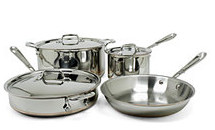Should you purchase a whole set of pots or buy them one at at a time?
Over the years I purchased a few pots and pans made by Calphalon, still use them today but can also recommend All Clad, Viking and Circulon. Since I bought my pans years ago, they have come up with some great new technology including handles that don't get hot and a better selection of non stick products.
I purchased my pans over time and in the end it has probably cost me more than just buying a complete set. At the time though, I didn't have the bucks to buy a whole set so it didn't matter. I still enjoy shopping for new pans and love when my wife surprises me on my birthday or during the holidays.
If you don't purchase a complete set, buy a couple of good quality essentials and add to your collection as you go along. Like investing in stocks, you wouldn’t buy your whole portfolio at one time but add to it when the market is right. See below for some good RESOURCES.
Cookware Pot Information Posted By: Blueshoots.com
Orignal Source :http://www.reluctantgourmet.com/


